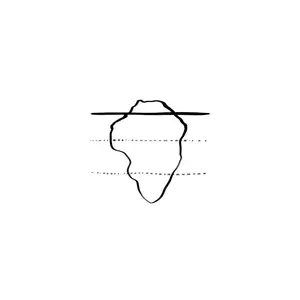The Iceberg Model

The Iceberg Model is a diagnostic tool that is used to analyze systemic structures and identify blind spots that cause a team/organization/society to collectively reproduce results that no one wants.
Goal
The Iceberg Model makes underlying structures, paradigms of thought, and sources visible. When these are ignored, they keep teams locked into reenacting patterns of the past.
Instructions
Application
The Iceberg Model lets participants:
- identify leverage points that allow a system to shift from operating at levels 1 (behavior) and 2 (process & structures) to levels 3 (paradigms of thought) and 4 (sources of inspiration).
- address challenges on the level that they are created so that they can be transformed.
- shift perception from inside individual heads to outside organizational boundaries (the field).
- facilitate a collapse of the boundary between observer (an individual) and observed (a system) and recognize that “I am part of the problem.”
- create optimal conditions for decision making by recognizing the source-level of awareness.
Principles
When using the Iceberg Model as a tool, consider applying the lens of the Matrix of Social Evolution to
the place from which your perception arises:
• Attend from downloading, to seeing, to sensing, to presencing
• Converse from downloading, to debate, to dialogue, to co-creative flow/presencing
• Organize from centralized, to decentralized, to networked, to ecosystem
• Govern from hierarchy, to markets, to negotiation, to awareness-based collective action
Process
Setup
- People: This practice can be done individually or in a group.
- Place: This tool can be used anywhere.
- Time: 15–30 minutes.
- Materials: Use the worksheet on the following page. Or gather appropriate writing materials and redraw the worksheet large on a flip chart.
Steps
Step 1: “Scale Down”
Scale down the iceberg on the left by answering the following questions about your current reality:
- What behaviors and events are we are seeing?
- What structures are shaping those behaviors and events?
- What beliefs and mental models are shaping the structures?
- What levels of awareness are shaping the beliefs and mental models?
Step 2: “Scale Up”
Now scale up by answering these questions:
- What levels of awareness do we need to be operating from?
- What beliefs and mental models will support the shift?
- What structures will be needed?
- What behaviors and events would we like to see as outcomes?
Step 3: Debrief and Conclude
- When you are finished, debrief with a colleague or as a team.
- Retain the drawing for reference as you proceed through the rest of the program.
Resources
- Bird, Kelvy. 2018. Generative Scribing: An Art of the 21st Century, Cambridge, MA: PI Press.
- Scharmer, Otto. 2007. Theory U, Second Edition, Chapters 10, 15. Oakland, CA: BerrettKoehler.
- Senge, Peter. 1990. The Fifth Discipline, New York, NY: Currency Doubleday.
Attachments
- iceberg_model_cover.webp
Background
Reproduced under CC License and with credit to the Presencing Institute.
Author
Facilitation methods and techniques reproduced in the SessionLab Library under the appropriate Creative Commons license. All methods contain attribution to the source material and are reproduced with permission.
More about author